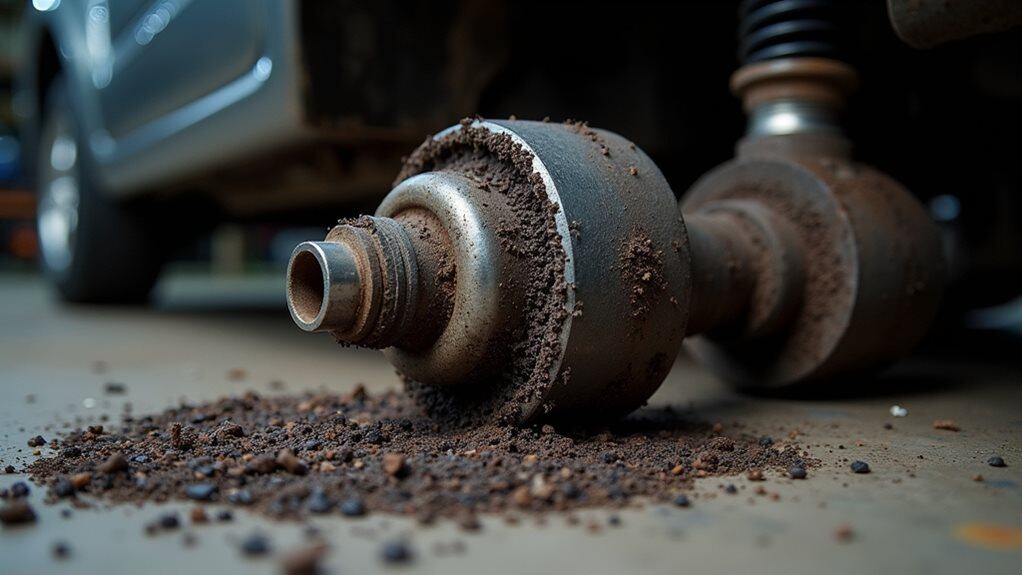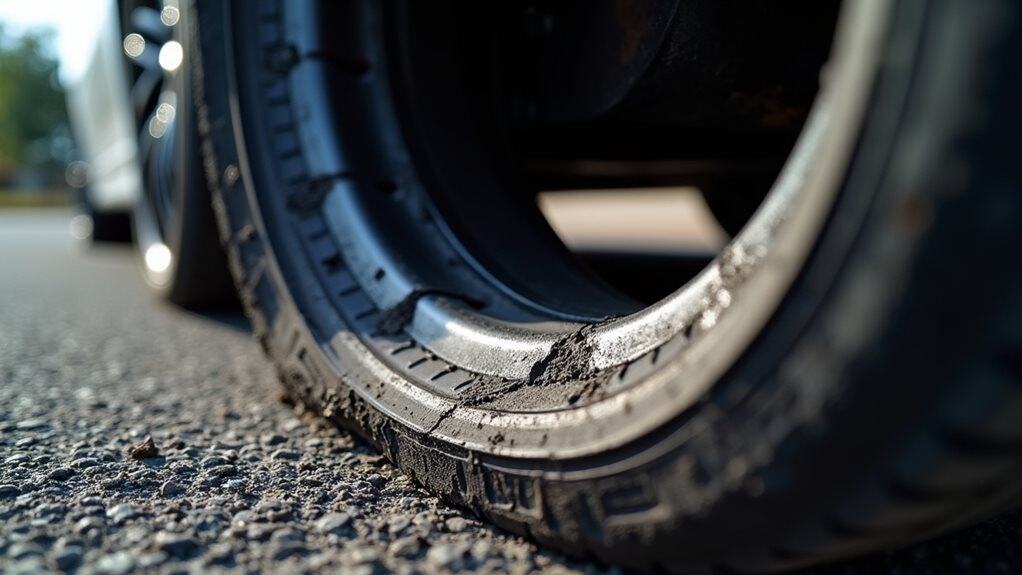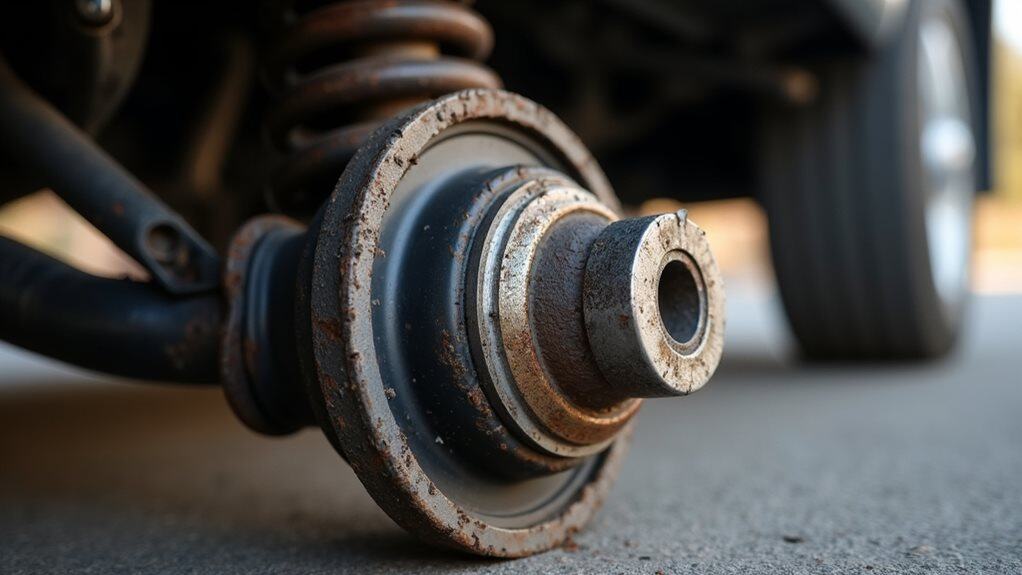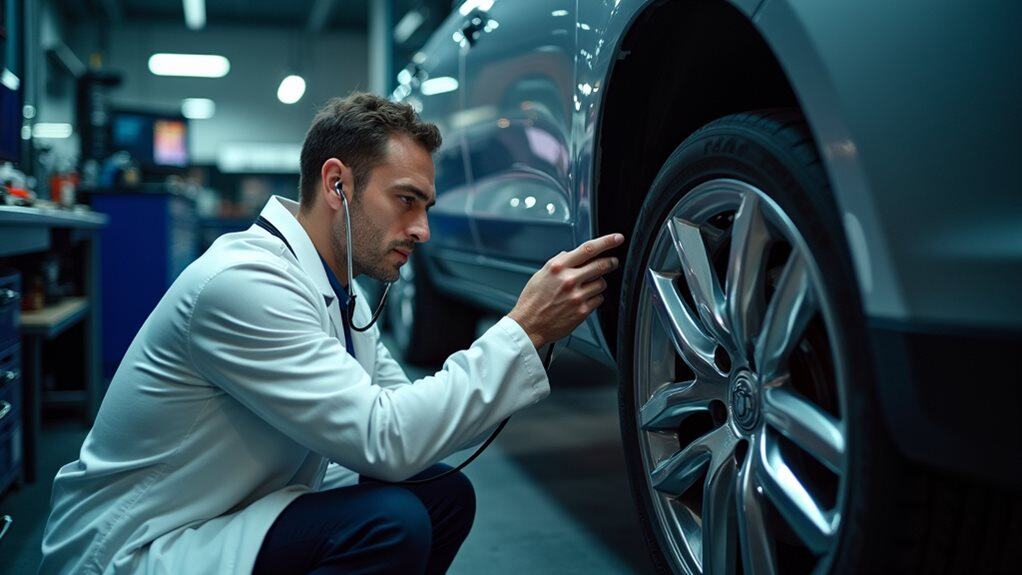Bad alignment noise manifests as high-pitched squealing during turns, steering wheel vibrations with humming sounds, and drumming noises from uneven tire wear. You’ll notice these issues after hitting potholes or curbs, which knock your wheels out of proper positioning. Worn suspension components like ball joints and struts worsen the problem, creating scraping sounds as tires fight against pavement. Professional alignment correction typically costs $75-200 but prevents dangerous handling issues and premature tire replacement. Understanding these warning signs helps you address problems before they escalate.
Quick Tips
- Bad alignment noise includes high-pitched squealing during turns, humming sounds, and drumming noises from uneven tire wear.
- Misalignment occurs from road impacts, worn suspension components, improper tire pressure, and aggressive driving habits.
- Warning signs include vehicle pulling to one side, crooked steering wheel, and persistent squealing or grinding sounds.
- Fix alignment issues through professional wheel alignment service, suspension component replacement, and proper tire pressure maintenance.
- Prevent future problems by avoiding road hazards, checking alignment every 6,000 miles, and rotating tires regularly.
What Causes Bad Alignment Noise in Your Vehicle

When your vehicle’s wheels aren’t properly aligned, they create distinctive noises that signal underlying mechanical problems requiring immediate attention.
Road impacts from potholes or curbs cause immediate misalignment, while worn suspension components like shocks, struts, and ball joints can’t maintain proper wheel positioning. Ball joints are crucial in allowing for steering movement, and their deterioration can exacerbate alignment issues.
Improper tire pressure and aggressive driving habits also contribute to alignment-related noise issues. These alignment problems can cause tires to make a squealing sound as they scrape against the pavement instead of rolling smoothly.
Types of Noises That Indicate Alignment Problems
Understanding the root causes of alignment issues helps you recognize the specific sounds your vehicle makes when these problems occur.
You’ll hear high-pitched squealing during turns when tires scrape pavement instead of rolling smoothly. Additionally, unbalanced wheels can contribute to vibrations and noises that indicate misalignment.
Steering wheel vibrations accompany humming sounds, while uneven tire wear creates drumming noises.
Low-frequency humming from irregular tire movement indicates deteriorating alignment. These sounds often develop after hitting potholes, which is the most common cause of alignment problems.
How Bad Alignment Affects Vehicle Handling and Safety

While those alignment-related noises serve as early warning signs, the real danger lies in how misalignment compromises your vehicle’s fundamental ability to respond predictably to your driving inputs. You’ll experience reduced stability during emergency maneuvers, compromised traction on curves, and increased stopping distances up to 20% in adverse conditions, markedly elevating your crash risk. Regular wheel alignment is essential for extending tire lifespan, as it helps to maintain optimal vehicle performance and safety.
Key Warning Signs to Watch For
When your vehicle’s wheels aren’t properly aligned, you’ll notice several distinct warning signs that indicate it’s time for professional attention.
The most obvious symptom is your car pulling to one side while driving straight, which forces you to constantly correct your steering to maintain your lane position.
You’ll also hear unusual tire noises like squealing or scraping sounds during acceleration and turns, which occur because misaligned wheels cause uneven tire contact with the road surface. Additionally, worn tire components can exacerbate these noises, further indicating a need for alignment and maintenance.
Vehicle Pulling Sideways
How do you know if your vehicle’s alignment has gone bad and is causing dangerous pulling?
You’ll notice your car drifting to one side without steering input, requiring constant corrections to maintain straight travel. This pulling sensation becomes more pronounced at highway speeds, creating serious safety risks.
Your steering wheel may also appear crooked when driving straight ahead.
Unusual Tire Noises
Your vehicle’s tires can serve as early warning systems, producing distinct sounds that signal alignment problems before they become dangerous or costly.
Listen for persistent squealing during turns, womp-womp noises from underinflated tires, grinding sounds indicating worn wheel bearings, thumping from uneven tread wear, or drumming noises suggesting misalignment issues requiring immediate attention.
Suspension Components That Create Alignment Noise

Although alignment noise can stem from various sources, specific suspension components serve as the primary culprits when your vehicle starts producing unwanted sounds.
Control arm bushings create clunking noises when worn, altering suspension geometry. Ball joints produce similar sounds while affecting steering stability.
Sway bar links contribute to handling issues, and deteriorating wheel bearings cause vibrations that indirectly impact alignment.
Impact on Tire Wear and Vehicle Performance
When worn suspension components create alignment noise, they simultaneously trigger a cascade of tire wear patterns that directly compromise your vehicle’s performance and safety.
You’ll notice toe wear on tire edges, camber wear across treads, and localized bald spots.
This uneven wear reduces traction, causes steering wheel vibration, increases fuel consumption, and creates dangerous pulling that requires constant correction while driving.
Professional Diagnosis and Repair Options

Since bad alignment noise typically indicates underlying mechanical problems that require precise measurement and adjustment, you’ll need professional diagnosis to identify the exact cause and extent of the issue.
Skilled technicians use computerized alignment systems and laser tools to measure wheel angles accurately, then adjust camber, toe, and caster settings to manufacturer specifications.
Prevention Tips to Avoid Future Alignment Issues
You can prevent costly alignment problems and eliminate those annoying noises by following three key strategies that protect your vehicle’s suspension system.
First, you’ll need to establish a regular maintenance schedule that includes alignment checks every 6,000 miles, proper driving habits that avoid road hazards like potholes and curbs, and consistent tire care that maintains correct pressure and rotation patterns.
These preventive measures work together to keep your wheels properly aligned, which saves you money on premature tire replacement and guarantees your vehicle drives smoothly without pulling or making grinding sounds.
Regular Maintenance Schedule
Although most drivers focus on oil changes and tire rotations, establishing a regular wheel alignment schedule represents one of the most cost-effective preventive maintenance strategies for your vehicle.
You should check alignment every 6,000 to 10,000 miles or annually. Include these inspections during routine maintenance appointments, where technicians use computerized alignment machines for precise measurements and early problem detection.
Proper Driving Habits
Beyond scheduling regular inspections, your daily driving choices play a significant role in preserving wheel alignment and preventing costly repairs.
Avoid potholes and curbs when possible, as impacts cause misalignment. Practice smooth acceleration and gradual braking to reduce tire stress.
Take turns at moderate speeds, maintain steady speeds on highways, and slow down on rough road surfaces.
Tire Care Basics
Five essential tire care practices can prevent alignment problems before they start, saving you hundreds of dollars in premature tire replacement and costly repairs.
Check tire pressure monthly using manufacturer-recommended levels, not sidewall numbers.
Rotate tires every 5,000-7,000 miles to promote even wear.
Avoid potholes and curbs that knock wheels out of alignment unexpectedly.
Wrapping Up
You’ll prevent costly repairs and dangerous driving conditions by addressing alignment noise immediately. Don’t ignore squealing, grinding, or clunking sounds from your suspension components, as they indicate worn parts that compromise vehicle safety. Schedule regular alignment checks every 6,000 miles or when you notice uneven tire wear. By maintaining proper wheel alignment and replacing worn suspension components promptly, you’ll extend tire life, improve fuel efficiency, and guarantee peak vehicle handling performance.

